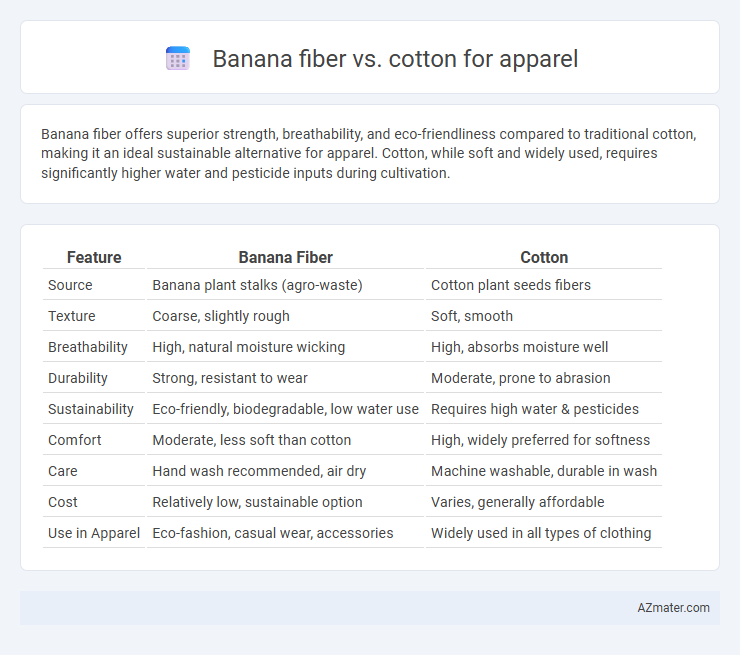Banana fiber offers superior strength, breathability, and eco-friendliness compared to traditional cotton, making it an ideal sustainable alternative for apparel. Cotton, while soft and widely used, requires significantly higher water and pesticide inputs during cultivation.
Table of Comparison
| Feature | Banana Fiber | Cotton |
|---|---|---|
| Source | Banana plant stalks (agro-waste) | Cotton plant seeds fibers |
| Texture | Coarse, slightly rough | Soft, smooth |
| Breathability | High, natural moisture wicking | High, absorbs moisture well |
| Durability | Strong, resistant to wear | Moderate, prone to abrasion |
| Sustainability | Eco-friendly, biodegradable, low water use | Requires high water & pesticides |
| Comfort | Moderate, less soft than cotton | High, widely preferred for softness |
| Care | Hand wash recommended, air dry | Machine washable, durable in wash |
| Cost | Relatively low, sustainable option | Varies, generally affordable |
| Use in Apparel | Eco-fashion, casual wear, accessories | Widely used in all types of clothing |
Introduction: The Rise of Sustainable Fibers
Banana fiber, derived from the pseudo-stems of banana plants, offers a biodegradable and eco-friendly alternative to traditional cotton in apparel production. Compared to cotton, which requires significant water and pesticide use, banana fiber cultivation promotes sustainable agriculture with minimal environmental impact. This growing interest in banana fiber reflects the fashion industry's shift toward renewable, low-impact materials that support circular economy principles.
Overview of Banana Fiber and Cotton
Banana fiber, derived from the pseudo-stems of banana plants, is a sustainable and biodegradable natural fiber known for its strength, durability, and smooth texture, making it ideal for eco-friendly apparel. Cotton, one of the most widely used natural fibers in the textile industry, offers softness, breathability, and moisture absorption but requires significant water and pesticide inputs during cultivation. Both fibers present distinct environmental and performance characteristics that influence their suitability for different apparel applications.
Environmental Impact: Banana Fiber vs Cotton
Banana fiber generates significantly lower environmental impact compared to cotton, requiring less water and no synthetic pesticides during cultivation. Cotton farming is water-intensive, consuming approximately 20,000 liters per kilogram, and often involves heavy pesticide use, which harms biodiversity and soil health. The biodegradable nature of banana fiber also promotes sustainable waste management, making it a more eco-friendly choice for apparel production.
Fiber Properties and Characteristics
Banana fiber exhibits high tensile strength and biodegradability, making it a durable and eco-friendly choice for apparel compared to cotton, which is softer but less resilient. Banana fibers have a coarse texture and natural luster, providing a rustic look ideal for sustainable fashion, while cotton fibers are finer with superior moisture absorption, enhancing comfort and breathability. The moisture management and antimicrobial properties of banana fiber complement its thermal insulation, whereas cotton excels in softness and ease of dyeing due to its natural cellulose content.
Processing and Manufacturing Differences
Banana fiber production involves extracting fibers from banana plant pseudostems through water retting or mechanical decortication, followed by drying and combing, whereas cotton processing includes harvesting, ginning to separate fibers from seeds, and carding to prepare the fiber for spinning. Banana fibers are naturally coarse and require additional softening treatments to achieve apparel-grade fineness, while cotton fibers have inherent softness, making them easier to spin into fine textiles. Manufacturing banana fiber textiles often involves blending with other fibers to enhance flexibility and durability, contrasting with purely cotton-based apparel that relies on established spinning and weaving techniques.
Comfort and Wearability in Apparel
Banana fiber offers superior breathability and moisture-wicking properties compared to cotton, enhancing comfort in warm climates and active wear. Its natural stiffness provides durability, while processed banana fiber can be softened to rival cotton's smooth texture, improving wearability. Unlike cotton, banana fiber is also hypoallergenic and resistant to bacterial growth, contributing to better skin health during prolonged use.
Durability and Longevity Comparison
Banana fiber offers superior durability compared to cotton, boasting high tensile strength and resistance to wear and tear, which extends the lifespan of apparel made from it. Cotton, while soft and breathable, tends to wear out faster due to lower fiber strength and susceptibility to abrasion. Choosing banana fiber for clothing enhances garment longevity, making it a sustainable option for durable apparel.
Cost and Market Availability
Banana fiber offers a cost-effective alternative to cotton, with lower raw material expenses due to the use of agricultural waste from banana plants. Cotton remains more widely available in global markets, benefiting from established supply chains and large-scale cultivation, which ensures consistent production volumes. Market demand for sustainable textiles is increasing interest in banana fiber, but cotton still dominates due to its affordability and extensive infrastructure.
Fashion Industry Adoption Trends
Banana fiber is gaining traction in the fashion industry due to its sustainability, biodegradability, and unique texture, offering an eco-friendly alternative to conventional cotton. While cotton remains dominant for its softness and versatility, rising concerns about water-intensive cultivation and pesticide use have driven designers toward banana fiber blends. Emerging brands prioritize banana fiber for its durability and natural sheen, reflecting a shift toward responsible sourcing and innovation in apparel manufacturing.
Future Outlook: Banana Fiber and Cotton in Apparel
Banana fiber offers a sustainable alternative to cotton in apparel, boasting natural biodegradability, moisture-wicking properties, and high tensile strength that appeal to eco-conscious consumers and brands. Innovations in processing technology are enhancing banana fiber's softness and durability, positioning it as a viable competitor in the textile market traditionally dominated by cotton. With growing environmental regulations and increasing consumer demand for sustainable fabrics, the future outlook for banana fiber in apparel indicates significant growth potential alongside or as a complement to conventional cotton.

Infographic: Banana fiber vs Cotton for Apparel
 azmater.com
azmater.com